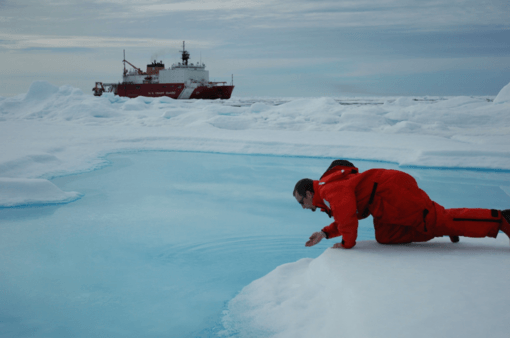
Photo by NOAA Photo Library | CC BY 2.0
Every once in a while a climatic event hits that forces people to sit down to catch their breath. Along those lines, abnormal Arctic heat waves in the dead of winter may force scientists to revaluate downwards (or maybe upwards, depending) their most pessimistic of forecasts.
By the end of February 2018, large portions of the Arctic Ocean north of Greenland were open blue water, meaning no ice. But, it’s wintertime, no daylight 24/7, yet no ice in areas where it’s usually some meters thick! In a remarkable, mindboggling turn of events, thick ice in early February by month’s end turned into wide open blue water, metaphorically equivalent to an airline passenger at 35,000 feet watching rivets pop off the fuselage.
The sea ice north of Greenland is historically the thickest, most solid ice of the North Pole. But, it’s gone all of a sudden! Egads, what’s happening and is it a danger signal? Answer: Probably, depending upon which scientist is consulted. Assuredly, nobody predicted loss of ice north of Greenland in the midst of winter.
Wide open blue seas in the Arctic expose all of humanity to risks of Runaway Global Warming (“RGW”) as, over time, massive amounts of methane erupts with ancillary sizzling of agricultural crops, and as the Arctic heats up much faster than the rest of the planet, this also throws a curve ball at weather patterns all across the Northern Hemisphere, radical weather patterns ensue, like snow on the French Riviera only recently.
According to Ruth Mottram, a climate scientist at the Danish Meteorological Institute in Copenhagen, February was the warmest (hottest) on record in the Arctic, which includes 10 days of temps above freezing. As for Arctic temps in February, that’s hot! “We’ve actually got open water at the top of Greenland right now, which is incredibly unusual,” (Mottram – Source: Europe’s Cold Blast, Arctic’s Heat Wave are ‘Two Sides of the Same Coin,” Public Radio International, March 2, 2018).
“This is an anomaly among anomalies. It is far enough outside the historical range that it is worrying – it is a suggestion that there are further surprises in store as we continue to poke the angry beast that is our climate,” said Michael Mann, director of the Earth System Science Center at Pennsylvania State University. (Source: Jonathan Watts, Global Environmental Editor, Arctic Warming: Scientists Alarmed by ‘Crazy Temperature Rise’, The Guardian, Feb. 27, 2018).
During February the world’s most northerly weather station at Cape Morris Jesup on the tip of Greenland registered temps warmer than London and Zurich for days on end. The Cape Morris Jesup weather station is only 440 miles away from the North Pole.
When analyzing or writing about the complexities of ecosystem events, like loss of Arctic sea ice, it is easy to overstate negatives, if only because there is no evidence of a similar event in recent climate history. Furthermore, the scientific community is widely split on likely consequences, running the gamut from “no worries for at least 100 years” to “the world will incinerate within 10 years,” meaning Runaway Global Warming (RGW”), as a result of massive release of methane (“CH4”) trapped in frozen waters for millennia, causing temps to crank up by 10 °F-to-15 °F, which will pretty much wipe out a lot of agricultural crops. In turn, the world turns into a dystopian hellhole and reverts to caveman/cavewoman lifestyle.
Indeed, the dangers that arise with loss of Arctic ice are multifold, including loss of the Arctic as the planet’s biggest reflector/air conditioner. When covered with white reflective ice, it reflects up to 90% of solar radiation back into outer space. Without ice, that same 90% is absorbed within a dark blue background, potentially heating up tons upon tons, and more tons yet, of frozen methane, metaphorically similar to throwing kindling onto a hot fire, as global warming heats up big time and sizzles agricultural crops down to blackened stubs throughout the mid latitudes, driving humanity into the farthest northern latitudes for survival, a crowded scenario indeed.
Generally speaking, people shrug their shoulders with a signal of “so what” when confronted with the risks of global warming/climate change. After all, nothing horrible will happen until well into the latter part of this century, or beyond, right? Well, yes and no, as the real issue that comes into play is timing. How fast is climate change/global warming happening?
And that’s the rub because, across the board, scientists agree ecosystem changes today are exponential, which could be problematic. As explained by one scientist, linear versus exponential means that a person can take 30 linear steps to the water cooler across the room but if exponential, the 30 steps takes him/her around the world, more than once. That’s exponential, and that’s the rate of change in ecosystems, like the Arctic. Therein lies the unknown risk factor of how soon temps mushroom upwards? Nobody knows for sure, but they do know that ecosystems are changing exponentially, especially in the ocean.
Here’s the ultimate risk: 55 million years ago global temps spiked during the Palaeocene-Eocene Thermal Maximum (“PETM”). The temp surge by 6 °C (11 °F) happened in just 13 years, which if repeated today, would be unbelievably devastating, but the science is controversial as to the timing of the surge 55 millions ago. Some scientists say 13 years; some scientists that look at the same data say 1500 years. Hopefully, it’s the latter. But unfortunately, with exponential change already underway, that wish does not look very promising.
Postscript: “The greatest shortcoming of the human race is our inability to understand the exponential function.” (Albert A. Bartlett 1923-2013, American Physicist)